Reissue - The final two paragraphs and last data table in this article have been modified. No other information in this product has been affected by these changes.
Skills shortages in Western Australia: Part 2
This article is published in the March Quarter 2006 issue of Western Australian Statistical Indicators, ABS cat. no. 1367.5.
INTRODUCTION
Since the beginning of Western Australia's current period of economic expansion in 2001-02, the state has experienced shortages of skilled labour across many occupations and related industries. Shortages have mainly been in the occupation groups of Tradespersons and Professionals as a result of rapidly growing demand from the industries of Mining, Property and business services, Manufacturing and Construction. This article will expand on the previous analysis published in the December quarter 2005 edition of this publication, which identified the existence and extent of the skills shortage across the economy. It will investigate the factors contributing to the shortage of skilled labour in the state and the impact it has had on the Western Australian economy, focusing on why many occupations have experienced a growing number of skilled vacancies between 2001-02 and 2004-05.
MAJOR FINDINGS
The Western Australian economy has expanded rapidly since 2001-02, which has moved the economy closer to full employment. High levels of consumption, business investment, property market and construction activity and international demand for the state's resource commodities has fuelled the demand for skilled labour and placed considerable pressure on the labour supply. In turn, the labour supply has been constrained to varying degrees by population growth, an ageing labour force and reduced education and training activity.
The Western Australian economy slowed in 2004-05, coinciding with the height of the skills shortages in the state. The extent to which the skills shortage caused that slowdown is not known, but given that labour is an important component of output in many of the industries driving the economy and also the industries most affected by the skills shortage, it is likely to have had a significant impact.
Western Australia is very reliant on the industries of Mining, Manufacturing, Construction and Property and business services as sources of economic growth, and all of these industries showed signs of slowing in 2004-05. Manufacturing and Property and business services recorded declines in economic growth in the last year, while business investment slowed in the Mining industry. Newspaper reports also indicated that some of the state's major development projects have been deferred as a result of rising labour costs and lack of suitably qualified workers. The Construction industry, despite continuing to grow at a healthy rate, has seen the amount of work in its pipeline increase substantially in recent years, mainly due to an insufficient supply of tradespersons. Skills shortages also appear to have had an effect on raising wages and consumer prices in the state, both of which have risen at rates well above national averages.
SKILLED VACANCIES BY OCCUPATION
The Department of Employment and Workplace Relations provides counts of advertised skilled vacancies by occupation in major metropolitan newspapers. These counts provide a broad indication of skilled shortages in Western Australia, although there are other recruitment methods not covered by these statistics (e.g. Internet advertisements). The following table displays the occupations in Western Australia that have experienced some of the largest increases (and decreases) in skilled vacancies over the period of skills shortage, from 2001-02 to 2004-05.
SKILLED VACANCIES BY OCCUPATION GROUP |
|  |
 | 2001-02 | 2004-05 | Change |  |
| Occupation group(a) | no. | no. | no. | % |  |
|  |
| Construction trades | 867 | 3 611 | 2 745 | 316.7 |  |
| Metal trades | 864 | 3 431 | 2 567 | 297.3 |  |
| Electrical and electronics trades | 390 | 1 206 | 816 | 209.5 |  |
| Automotive trades | 608 | 1 142 | 534 | 87.7 |  |
| Building and engineering professionals | 466 | 770 | 304 | 65.3 |  |
| Food trades | 239 | 515 | 276 | 115.5 |  |
| Hairdressers | 285 | 480 | 195 | 68.4 |  |
| Wood and textile trades | 180 | 347 | 167 | 92.8 |  |
| Chefs | 627 | 792 | 165 | 26.2 |  |
| Science professionals | 175 | 310 | 135 | 77.4 |  |
| Building and engineering associates | 279 | 376 | 97 | 34.6 |  |
| Miscellaneous | 116 | 180 | 64 | 54.7 |  |
| Printing trades | 52 | 80 | 28 | 53.8 |  |
| Medical and science technical officers | 24 | 43 | 19 | 77.1 |  |
| Organisation and information professionals | 69 | 82 | 13 | 19.0 |  |
| Social professionals | 178 | 186 | 8 | 4.5 |  |
| Marketing and advertising professionals | 36 | 27 | -9 | -25.0 |  |
| Computing professionals | 165 | 83 | -82 | -49.5 |  |
| Health professionals | 1 211 | 981 | -230 | -19.0 |  |
| Accountants and auditors | 694 | 305 | -389 | -56.1 |  |
| Total | 7 521 | 14 942 | 7 421 | 98.7 |  |
|  |
| (a) Occupation groups are ranked from highest to lowest based on growth in the number of skilled vacancies between 2001-02 and 2004-05. |
| Source: Department of Employment and Workplace Relations. |
Trade occupations have experienced some of the largest increases in skilled vacancies in Western Australia over the last three years, particularly Construction trades, which rose by 2,745 vacancies (316.7%) between 2001-02 and 2004-05. Among professional occupations, Building and engineering professionals recorded the largest rise in skilled vacancies, increasing by 304 vacancies or 65.3%. There were some occupations that showed a decline in skilled vacancies, including Accountants and auditors (down 389 vacancies or 56.1%), Health professionals (down 230 vacancies or 19.0%) and Computing professionals (down 82 vacancies or 49.5%). Despite the decline, the number of skilled vacancies for Health professionals (981) remained high in 2004-05 compared to most other occupations.
The reasons why particular occupations have experienced a rising number of skilled vacancies over recent years centre around the factors that drive labour demand and supply in the economy. These factors are discussed in the section below.
DEMAND FACTORS
In general, an expanding economy will create a greater level of demand for labour, as more workers are required to increase production to meet the growing demand for goods and services. More specifically, economic growth helps reduce cyclical unemployment in the short term, and through structural change creates new employment opportunities in the long term.
The Western Australian economy has recently experienced a period of rapid expansion, which has helped move the economy nearer to full employment. Characteristics of Western Australia's booming economy have included: high levels of domestic consumption expenditure; increased business profitability and investment; high levels of property market and construction activity; and strong exports growth from a surge in international demand for the state's resource commodities. All of these characteristics have had a positive impact on the demand for labour in the economy, placing considerable pressure on the state's labour supply, particularly skilled labour.
Generally, an economy can be expected to grow at least in line with population growth. However, in recent years, economic growth in Western Australia has outpaced population growth, which has increased the demand for labour above expected levels. Between 2001-02 and 2004-05, Western Australia's population grew by 4.4% or at an annual average rate of 1.4%.
GROSS STATE PRODUCT
The Western Australian economy grew strongly in the three years to 2003-04, with Gross State Product (chain volume measures) increasing by 5.6% in 2001-02 and 2002-03 and by 8.1% in 2003-04, much higher than the long run average of 4.1%. However, in the most recent year (2004-05) growth fell below the long run average to 2.7%, suggesting that shortages of skilled labour may have had some impact on constraining growth in the economy.
GROWTH IN GROSS STATE PRODUCT, Chain volume measures
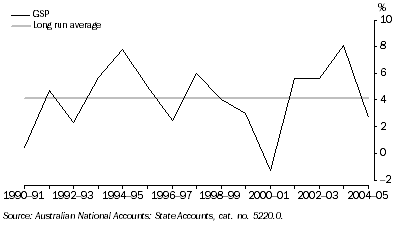
The average rate of growth in the Western Australian economy over the last four years was 5.5%, much higher than the previous four year period of 2.9%. Coinciding with this growth, was an acceleration in employment growth from 1.1% in 2001-02 to 4.2% in 2004-05.
GROWTH IN GSP(a) AND EMPLOYMENT(b)
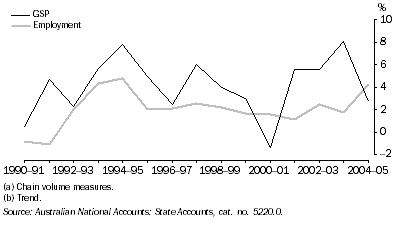
INDUSTRY GROWTH
The extent to which economic growth achieves higher employment depends on which industries the growth is concentrated in. Generally, growth in more labour intensive industries will have a greater effect on raising aggregate employment, than growth in more capital intensive industries. This was much the case for Western Australia during its recent period of expansion. Economic growth was widespread across a range of more labour intensive industries, most notably Property and business services and Health and community services, and it was in these types of industries that employment growth was strongest. However, Mining, a very capital intensive industry, also made a significant contribution to growth in state employment over the last three years.
Over the last three years, economic growth in Western Australia was mainly driven by the state's Mining industry, accounting for 21.7% of the increase in Gross State Product (GSP). The value of Mining production rose by an estimated 27.7% ($4,676 million) between 2001-02 and 2004-05. Despite Mining being a capital intensive industry, its rapid growth saw employment rise by 30.9% (9,900 persons) over the last three years, the fourth largest increase across all industries. Growth in Mining employment was also more than three times the 8.7% growth in total employment in Western Australia over the period. The sheer size and pace of growth achieved by this industry in recent years has been fuelled by the rapidly rising global demand for raw materials and increased investment in new production capacity and exploration, which has warranted significant increases in labour input.
ESTIMATED GROSS INDUSTRY PRODUCT AND INDUSTRY EMPLOYMENT(a) |
|  |
 |  | Estimated gross industry product | Industry employment |  |
 |  | 2001-02 | 2004-05 | Change | 2001-02 | 2004-05 | Change |  |
| Industry(b) | $m | $m | $m | % | '000 | '000 | '000 | % |  |
|  |
| Labour intensive industries: |  |  |  |  |  |  |  |  |  |
 | Property and business services | 8 042 | 10 992 | 2 950 | 36.7 | 100.4 | 119.6 | 19.2 | 19.2 |  |
 | Manufacturing | 7 164 | 9 417 | 2 254 | 31.5 | 88.8 | 96.6 | 7.8 | 8.8 |  |
 | Construction | 5 056 | 7 065 | 2 009 | 39.7 | 79.2 | 92.1 | 12.9 | 16.2 |  |
 | Health and community services | 4 373 | 5 703 | 1 330 | 30.4 | 86.3 | 98.7 | 12.4 | 14.4 |  |
 | Transport and storage | 3 492 | 4 617 | 1 124 | 32.2 | 38.7 | 42.6 | 3.9 | 10.1 |  |
 | Retail trade | 4 626 | 5 684 | 1 058 | 22.9 | 148.4 | 152.7 | 4.3 | 2.9 |  |
 | Wholesale trade | 3 252 | 3 974 | 722 | 22.2 | 47.0 | 46.6 | -0.5 | -1.0 |  |
 | Education | 2 602 | 3 141 | 539 | 20.7 | 68.7 | 70.6 | 1.9 | 2.8 |  |
 | Government administration and defence | 1 874 | 2 205 | 331 | 17.7 | 37.9 | 42.3 | 4.4 | 11.5 |  |
 | Accommodation, cafes and restaurants | 1 329 | 1 598 | 269 | 20.2 | 46.6 | 43.1 | -3.4 | -7.3 |  |
 | Personal and other services | 1 514 | 1 751 | 236 | 15.6 | 42.7 | 45.5 | 2.8 | 6.6 |  |
 | Cultural and recreational services | 771 | 970 | 199 | 25.8 | 22.2 | 22.6 | 0.5 | 2.1 |  |
 | Total(c) | 44 095 | 57 117 | 13 021 | 29.5 | 806.9 | 873.0 | 66.2 | 8.2 |  |
| Capital intensive industries: |  |  |  |  |  |  |  |  |  |
 | Mining | 16 906 | 21 582 | 4 676 | 27.7 | 32.2 | 42.1 | 9.9 | 30.9 |  |
 | Electricity, gas and water supply | 2 428 | 3 090 | 663 | 27.3 | 6.5 | 10.0 | 3.5 | 53.8 |  |
 | Finance and insurance | 3 316 | 3 909 | 593 | 17.9 | 27.7 | 26.2 | -1.5 | -5.4 |  |
 | Agriculture, forestry and fishing | 4 068 | 4 572 | 504 | 12.4 | 47.3 | 48.0 | 0.7 | 1.4 |  |
 | Communication services | 2 098 | 2 562 | 464 | 22.1 | 12.1 | 14.6 | 2.5 | 21.0 |  |
 | Total(c) | 28 816 | 35 715 | 6 900 | 23.9 | 125.8 | 140.9 | 15.1 | 12.0 |  |
| Western Australia(c)(d) | 79 400 | 100 900 | 21 500 | 27.1 | 932.5 | 1 013.9 | 81.4 | 8.7 |  |
|  |
| (a) Estimated Gross Industry Product at current prices. |
| (b) Industries are ranked from highest to lowest based on growth in estimated Gross Industry Product between 2001-02 and 2004-05. |
| (c) Discrepancies may occur between sums of component items and totals due to rounding. |
| (d) Includes the principal components Ownership of dwellings and General government not shown in the table. |
| Source: Australian National Accounts: State Accounts, cat. no. 5220.0; Labour Force, Australia, cat. no. 6202.0. |
Nearly all of the remaining GSP growth in Western Australia was driven by the more labour intensive industries, accounting for 60.6% of the state's GSP growth between 2001-02 and 2004-05. The most significant contributions came from Property and business services, Manufacturing, Construction and Health and community services. Resulting from the widespread increase in economic activity, employment across Western Australia's labour intensive industries rose by 8.2% (66,200 persons) over the last three years, accounting for 81.4% of the rise in state employment. The highest growth in employment in Western Australia was recorded by the Property and business services industry, followed by Construction and Health and community services.
DOMESTIC DEMAND
Employment or the demand for labour is closely linked to the aggregate level of consumption in the economy. As the demand for domestically produced goods and services increases, so does the requirement for labour in the production process. The Western Australian economy has been strongly driven by the consumption expenditure of households over recent years, which has helped raise the level of employment in the economy.
The demand for final goods and services in Western Australia rose by 23.1% or $16,867 million (trend chain volume terms) between 2001-02 and 2004-05, with almost half (45.1%) of that growth attributable to household consumption expenditure (up 18.8% or $7,614 million). Since 2001-02, growth in household consumption has increased from 3.8% to 6.5% in 2004-05. As a result, household final consumption expenditure peaked at $48,208 million in 2004-05, the highest level on record.
GROWTH IN HOUSEHOLD CONSUMPTION, Chain volume measures: Trend
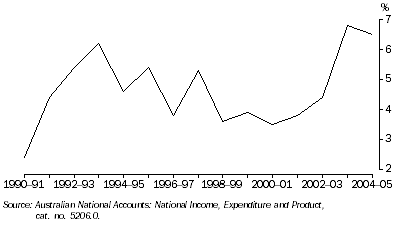
Despite growing demand for imported items such as furniture, white goods and motor vehicles in Western Australia, the consumption of goods and services produced domestically has also grown strongly over recent years. Between 2001-02 and 2004-05, expenditure increased markedly on Recreation and culture (up $1,414 million or 32.3%), Rent and other dwelling services (up $917 million or 13.0%), and Furnishings and household equipment (up $862 million or 34.1%). Other notable increases were in the consumption of goods and services relating to Health, Food and Hotels, cafes and restaurants - all rising by over $500 million.
The increase in consumption by Western Australian households on locally produced goods and services has translated into employment growth in related industries. The rise in household expenditure on Recreation and culture over the past three years has coincided with employment growth in the industries of Sport (up 1,600 persons or 22.5%), Parks and gardens (up 1,100 persons or 269.6%) and Libraries (up 300 persons or 17.6%). Growth in household spending on Rents and other dwelling services between 2001-02 and 2004-05 has helped fuel the rise in persons employed as Real estate agents, up 2,100 persons or 20.8%. Increased expenditure on Furnishings and household equipment has underpinned employment growth in Furniture, houseware and appliance retailing (up 1,700 persons or 11.6%) and Furniture manufacturing (up 700 persons or 11.4%). The increase in Food consumption has aided employment growth in Supermarket and grocery stores retailing (up 3,300 persons or 14.9%), Marine fishing (up 1,200 persons or 81.4%), Other food manufacturing (up 1,000 persons or 63.3%) and Meat and meat product manufacturing (up 600 persons or 15.3%).
Other notable occurrences of consumption-led employment growth were in expenditure on Hotels, cafes and restaurants stimulating employment in Pubs, taverns and bars (up 2,400 persons or 37.4%); and Health expenditure aiding employment in Medical and dental services (up 2,000 persons or 15.9%) and Veterinary services (up 1,300 persons or 294.7%).
INTERNATIONAL DEMAND FOR WESTERN AUSTRALIAN PRODUCTION
As with domestic demand, international demand for Western Australian produced goods and services also increases the demand for labour in the local economy. Economic conditions in the state's major export markets have a great bearing on economic activity and labour demand in Western Australia, with over 40% of the state's production shipped overseas each year. The state relies heavily on countries like Japan and China as markets for its goods and services, particularly resource commodities.
Over the last four years, economic conditions in Western Australia's major export markets have greatly improved, boosting investment and general economic activity in the state. This has led to a surge in demand for labour in industries like Mining, Manufacturing, Construction, Business services and Transport. Japan, the state's largest export market, has begun to recover from a prolonged period of weak growth, while China has continued to expand at an accelerated rate of around 9% per year, becoming the state's main driver of export growth in mineral and energy commodities. India has also emerged as a major export market for Western Australia, particularly for gold. Economic growth in India has accelerated from 3.9% in 2001 to 7.1% in 2005, with the last three years experiencing growth of above 7% per year. Thailand and Indonesia have been the other major export markets to grow strongly in recent years, both recording an average rate of growth of 4.8% per year, from 2001 to 2005.
Western Australia's recent period of economic expansion has been strongly influenced by the wave of activity in the state's resources sector, which has also flowed through into other parts of the economy. As a result, the demand for labour has increased in the Mining industry, as well as in related industries such as Metal products manufacturing, Construction, Business services and Transport. It has primarily been the surge in demand for raw materials from countries like China and India that has led this growth.
Since 2001-02, Western Australian exports to China doubled (up 105.3%) to over $6.5 billion in 2004-05, with 70.7% of that growth attributable to iron ore exports. The rest of the growth was spread across commodities like nickel, nickel ore, gold and base metals. Japan also increased its imports of Western Australian iron ore by $475 million or 21.8% over the period. India's demand for Western Australian gold has increased greatly over the last three years, from $144 million in 2001-02 to $2,773 million in 2004-05. Thailand also showed strong gains in gold imports from Western Australia, increasing by $944 million over the period. Another major export commodity to grow in demand over the last three years was crude petroleum oil, with Indonesia (up $396 million), Thailand (up $278 million), Singapore (up $270 million) and New Zealand (up $219 million) recording the strongest increases among the state's major trading partners.
It is no coincidence that the Mining and related industries of Western Australia have been among those most affected by skills shortages. The rapid and somewhat unexpected rise (at least in magnitude) in overseas demand for the state's resource commodities, mainly from China and India, has meant these industries have had to react quickly to increase production capacity. In the process the demand for skilled labour has also risen sharply.
Employment in Western Australia's Mining industry increased by 9,942 persons (30.9%) between 2001-02 and 2004-05. The number of employed persons rose across all sectors of the Mining industry, with the largest increase in Other mining, up 6,973 persons or 162.7% (Other mining includes people employed in the Mining industry who are not allocated to a specific sub-industry and who may be carrying out only part of a mining operation on a fee or contract basis - mainly providing specialist oil field services). There was also strong employment growth in Oil and gas extraction (up 1,312 persons or 91.2%) and Exploration (up 691 persons or 11.9%).
Among mining-related industries operating in Western Australia, there was strong employment growth in Technical business services, such as Surveying and Consultant engineering, much of which can be associated with mining operations in the state. Employment in Technical services rose by 4,165 persons or 26.2% over the three years to 2004-05. Basic non-ferrous metal manufacturing also showed strong employment growth, increasing by 2,532 persons or 71.8% over the period. This industry mainly engages in alumina production, aluminium smelting, and the smelting and refining of copper, silver, lead and zinc.
The recent expansion of Western Australia's resources sector has involved the construction of new infrastructure, which has increased the state's need for additional building and engineering professionals, as well as construction workers. Between 2001-02 and 2004-05, heavy industry engineering construction activity (commencements) rose by $1,423 million (144.5%) in Western Australia, from $985 million to $2,408 million. Heavy industry engineering construction activity includes the construction of production, storage and distribution facilities, refineries, pumping stations, mines, chemical plants, blast furnaces, steel mills, other industrial processing plants and ovens.
Concurrently, the number of persons employed as Building and engineering professionals (and associate professionals) has risen, many of whom could be expected to be employed in the Mining industry or contracted to it for a period of time, during such a dynamic period of expansion. Employment in Building and engineering professionals rose by 3,340 persons (29.3%) between 2001-02 and 2004-05, and includes Civil engineers, Electrical and electronics engineers, Mechanical, production and plant engineers and Mining and materials engineers. Engineers directly associated with the mining industry - Mining and materials engineers - increased by 935 persons or 65.9% over the period. Civil engineers (up 987 persons or 36.1%) and Mechanical, production and plant engineers (up 641 persons or 23.7%) also recorded strong employment growth in the state, as did Associate professionals of Building and engineering (up 343 persons or 40.5%).
BUSINESS PROFITABILITY
During periods of rising profits, businesses tend to employ more workers to raise production levels to take advantage of the higher profits margins on offer. In Western Australia, business profits rose by 28.7% or $11,375 million between 2001-02 and 2004-05. The main industries to realise increased profits over the period were Mining (up $3,307 million or 25.5%), Property and business services (up $1,366 million or 53.7%), Manufacturing (up $1,332 million or 47.6%) and Construction (up $761 million or 33.6%). It is not surprising that these industries were also the ones to record strong growth in production and labour demand in recent years, and be among those most affected by skills shortages in Western Australia.
CHANGE IN BUSINESS PROFITS(a), Current prices
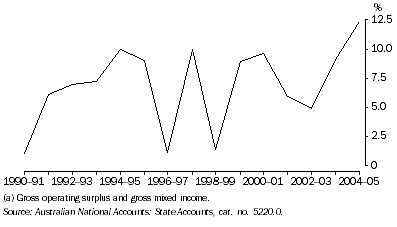
BUSINESS INVESTMENT
A number of factors have influenced the rapid growth in business investment over the last three years in Western Australia, including low interest rates, improved business profitability, strong global demand for raw materials and a high $A. Increased business investment activity in recent years has had a positive effect on labour demand. Between 2001-02 and 2004-05, business investment rose by 52.1% ($5,543 million) in Western Australia (chain volume measures), mainly driven by expenditure on new machinery and equipment and new engineering construction. The level of business investment in the state was at a near record high in 2004-05 at $16,190 million - only $756 million below the record of $16,946 million in 1997-98.
BUSINESS INVESTMENT, Chain volume measures
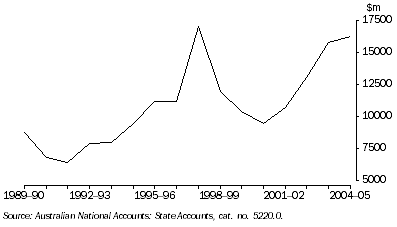
As with business profitability, the industries that have driven investment growth in Western Australia have also been among those most affected by shortages of skilled labour. In current price terms, investment grew strongly in Mining (up $2,440 million or 78.9%), Other selected industries (including Retail trade, Construction and Property and business services) (up $865 million or 40.4%) and Manufacturing (up $650 million or 85.5%), between 2001-02 and 2004-05.
HOUSING SECTOR ACTIVITY
Activity in Western Australia's housing sector has risen rapidly over the last three years. House prices have grown strongly, as has dwelling investment and residential building construction, all of which have fuelled the demand for labour in occupations such as tradespersons, construction materials manufacturing workers and property service workers.
Dwelling investment (chain volume measures) in Western Australia rose by 12.3% ($632 million) between 2001-02 and 2004-05. This result was much higher than the increase of 2.0% ($89 million) between 1997-98 and 2000-01. The level of dwelling investment reached a peak of $5,756 million in 2004-05, only $52 million less than the record high in 1999-2000, just prior to the introduction of the GST.
DWELLING INVESTMENT, Chain volume measures

Rising dwelling investment was translated into increased dwelling construction activity over recent years. The number of dwellings commenced rose by 20.7% (3,939 units) between 2001-02 and 2004-05 in Western Australia. To put this in perspective, the growth in dwelling commencements since 2001-02 was almost ten times the rate in annual average terms than it was in the previous four year period (12.9% per year compared to 1.3% per year). In each year since 2001-02, dwelling construction has grown to reach a high of 22,941 units commenced in 2004-05 - only 1,951 less than the previous peak in 1993-94 of 24,892 units, when the Construction industry began to recover from a period of slow growth.
BUILDING ACTIVITY, Dwellings commenced: Trend
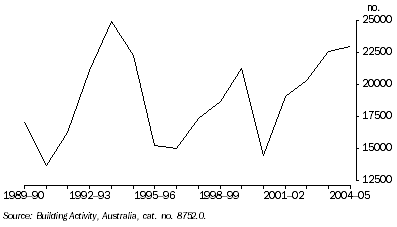
Increased activity in the state's housing sector has underpinned employment growth in a number of related industries. The strongest growth was recorded in Building structure service workers (which includes concreters, bricklayers, roof tilers and metal roof fixers), rising by 3,500 persons (47.3%) between 2001-02 and 2004-05. The second highest employment growth over the period was in Other construction services (primarily landscapers), increasing by 3,100 persons (46.6%). Employment in Building completion services recorded the third highest rise, increasing by 3,000 persons (16.4%), mainly consisting of plasterers, carpenters, tilers (wall and floor), painters and glaziers.
In the Manufacturing industry, there was substantial employment growth in Prefabricated building manufacturing, increasing by 700 persons (152.3%) between 2001-02 and 2004-05, with workers mainly engaged in manufacturing prefabricated metal buildings, carports, garages and sheds.
COMPETITION FOR LABOUR
Reflecting the widespread nature of Western Australia's economic growth over the last three years, competition for labour has risen across a range of industries in the state, exacerbating the problem of skills shortages. There has been an increase in demand for most occupations throughout the economy, although some industries have shown stronger demand for particular occupations than others, reflecting the relative strength of growth in the industry.
The largest growth in employment was in the occupation group of Managers and Administrators, increasing by 22,900 persons (37.5%) between 2001-02 and 2004-05. This was the only occupation group in Western Australia to have increased employment across all of the state's industries, although one third (32.7%) of the growth was concentrated within Property and business services and Manufacturing. The second largest rise in employment was in Associated professionals, rising by 12,700 persons (10.8%) from 2001-02 to 2004-05. Most (79.8%) of the growth came from the industries of Health and community services, Property and business services and Mining. Tradespersons and related workers recorded the third highest increase in employment over the last three years, rising by 11,500 persons or 8.9%. The demand for Tradespersons and related workers was strong across a wide range of industries, with more than 1,000 additional tradespersons employed in each of Construction, Personal and other services, Mining, Manufacturing, Property and business services, Wholesale trade, Cultural and recreational services, Electricity, gas and water supply and Communication services. The only other occupation to record employment growth of greater than 10,000 persons between 2001-02 and 2004-05 was Intermediate production and transport workers (up 10,400 persons or 12.9%). The demand for this occupation group was also widespread across industries, with Mining, Retail trade and Construction accounting for most of the rise (81.1%).
SUPPLY FACTORS
The supply of labour in an economy is affected by factors such as population growth (including natural increase and migration), workforce participation and education and training, which helps to increase the stock of accumulated knowledge and skills in the workforce.
POPULATION GROWTH
Population growth results from natural increase (births minus deaths) and net migration (the gain from immigration less the loss from emigration). At the state level, net migration includes both overseas and interstate migration. In recent years, Western Australia's population growth has recovered from a lengthy period of deceleration. Population growth had slowed from 31,469 persons in 1995-96 to 23,394 persons in 2001-02, but has since increased to 32,034 persons in 2004-05.
POPULATION GROWTH
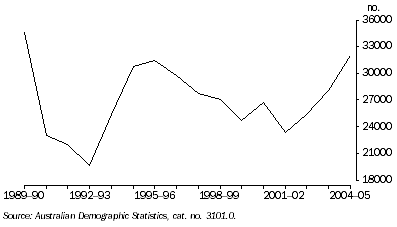
The effect population growth has on the labour supply will depend on which components drive the growth in population. Natural increase does not create an immediate increase in the supply of labour, as it is not until the person reaches 15 years of age that he or she can enter the workforce. Migration, on the other hand, has an immediate impact on the labour supply if migrants are of working age and well qualified. Migration not only has the ability to increase the quantity of workers in the state, but also the potential to raise the quality of the labour force by adding educated, trained and skilled workers.
Over the three years to 2004-05, Western Australia's population rose by 85,560 persons, with over half of that growth attributable to net migration (53.3%). These additional 45,622 persons did potentially add to the state's workforce, as 78.6% of arrivals into Western Australia were aged 15-65 years during this period. Therefore, around 35,800 potential workers were added to the state's labour supply between 2001-02 and 2004-05.
GROWTH IN NET MIGRATION
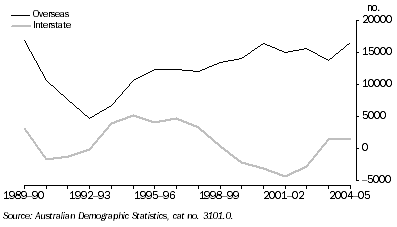
The declining rate of population growth over the last decade has had a negative impact on Western Australia's labour supply in recent years. Growth in net overseas arrivals to Western Australia, which had risen to a peak of 16,263 persons in 2000-01, had fallen to 13,634 persons in 2003-04. There was also a period early this decade when Western Australia lost a significant number of people to interstate migration. Between 1999-2000 and 2002-03, there was a net departure of 12,492 persons from Western Australia to other states and territories of Australia.
LABOUR FORCE PARTICIPATION
The impact of population growth on the supply of labour centres around its effect on increasing the rate of growth of the labour force. The labour force constitutes all persons employed and unemployed (actively seeking employment) in the civilian population aged 15 years and over. The size of the labour force is strongly influenced by population growth, but also by the participation of the population in the workforce, labour utilisation and the ageing of the labour force. Also important, particularly during a period of high demand for skilled labour, is the composition of occupations or skills in the labour force and whether there are enough workers available for each occupation or skill to satisfy demand.
Size of the labour force
Over the last four years, the size of the Western Australia labour force has grown at an annual average rate of 1.9% (19,590 persons), much lower than the long term (25 year) average growth rate of 2.5% (19,116 persons). The result would have been decidedly lower if it wasn't for the strong growth of 3.2% (32,750 persons) in 2004-05, which coincided with an acceleration in net overseas migration. The growth in the labour force had remained below the 25 year average for nine consecutive years between 1995-96 and 2003-04, until rising above the long run average in 2004-05. It was this relatively slow growth of the labour force prior to 2004-05, during a period of strong economic growth and rising labour demand, that would have contributed to the skills shortage in Western Australia.
GROWTH OF THE LABOUR FORCE: Trend
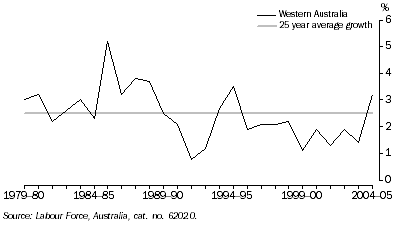
Given Western Australia's population growth has been relatively strong over recent years, other factors affecting the growth of the labour force, including labour force participation, the utilisation of labour and the age and occupation profile of the workforce, are likely to have played a part.
Participation in the labour force
The participation rate is the proportion of the civilian population aged 15 years and over in the labour force. The declining trend in the participation of workers in the state's labour force over the last decade partly explains the slow growth in the labour force over the period. More recently, and just prior to the strong rise in 2004-05, the participation rate in Western Australia experienced its largest decline in the last decade, falling from a peak of 66.4% in 2000-01 to 65.8% in 2003-04. However, in 2004-05, it reached an equal record high of 66.5% (1,064,346 persons). In that year, the state's working population grew strongly with the influx of workers from abroad and interstate, and marginally detached workers re-entered the workforce with the promise of better opportunities and higher wages.
PARTICIPATION RATE, Annual averages: Trend
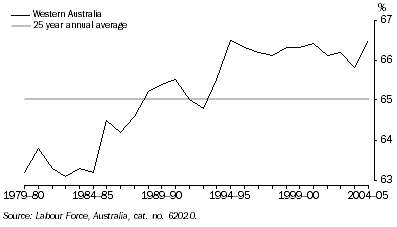
Labour utilisation
Strong demand for labour, coupled with slowing growth in labour force participation, have resulted in increasing utilisation of existing workers. Since the start of the skills shortage in Western Australia, the utilisation of workers in the labour force has grown, with average weekly hours worked rising from 34.7 hours in 2001-02 to 35.6 hours in 2004-05, as an initial response to the shortage of labour. As the utilisation of labour began to reach its peak in 2004-05, the number of persons employed in the state's workforce increased sharply, supplementing the rise in hours worked. However, prior to 2001-02, average weekly hours worked had been declining. In that year, average weekly hours worked fell markedly to 34.7 hours, from 35.4 hours in 2000-01.
AVERAGE WEEKLY HOURS WORKED
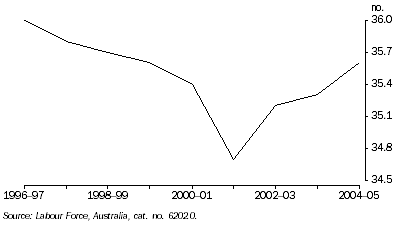
Ageing labour force
An ageing workforce detracts from the supply of workers in an economy by raising the rate of retirement from the labour force. The Western Australian labour force has been ageing rapidly since the mid-1990s, with the proportion of persons aged 55 years and over rising from 8.5% in 1996-97 to 13.7% in 2004-05. There was, however, a slight deceleration in the proportion of older workers in the labour force in 2004-05, indicating an increase in people aged 55 years and over retiring from the workforce (as well as the jump in net migration in 2004-05). This is further supported by the spike in the proportion of persons aged 55 years and over not in the labour force in 2004-05.
LABOUR FORCE, Proportion of persons aged 55 years and over
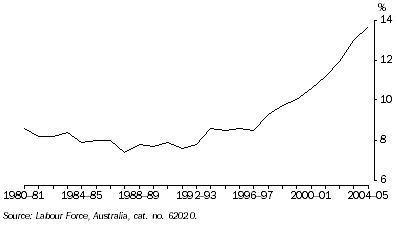
Since the late 1990's, the proportion of persons aged 55 years and over not in Western Australia's labour force continued to rise gradually, despite a dip in 2003-04. The proportion of persons aged 55 years and over not in the labour force rose from 52.2% in 1996-97 to 55.3% in 2004-05. Over the three years to 2004-05, the number of persons aged 55 years and over not in the labour force and who were permanently not intending to work or were no longer looking for work, rose by 19,058 persons or 7.5%. This loss of experienced workers from Western Australia's labour force would have had an impact on the supply of skilled workers over the period.
Supply of occupations or skills
Given labour shortages were more severe for certain occupations in Western Australia than others, the growth in the pool of workers for each occupation can be used to determine whether there were any deficiencies in the supply of those skills. A measure of the labour supply for each occupation can be created by aggregating the number of employed persons in each occupation and the number of unemployed persons by occupation of last job.
The supply of Managers and administrators recorded the largest increase among all occupation groups in Western Australia, rising by 22,618 persons or 36.5% between 2001-02 and 2004-05. This occupation group was previously identified as the fifth most affected by skills shortages in the state, suggesting that the demand for these skills continued to outpace supply. Similarly, the supply of Intermediate production and transport workers in Western Australia grew by 9,174 persons or 10.6% over the last three years, despite being identified as the fourth most affected by the skills shortage. The occupations identified as the three most affected by shortages in Western Australia - Professionals (up 8,177 persons or 4.8%), Tradespersons and related workers (up 8,138 persons or 6.0%) and Labourers and related workers (up 6,069 persons or 6.5%) - all recorded relatively moderate increases in labour supply.
Workers from the pool of unemployed persons in Western Australia have been drawn on quite extensively in recent years, which has seen unemployment fall rapidly in all occupations (based on the person's occupation of last job). Given shortages continued to be reported for many occupations, it seems likely that this source of labour supply was inadequate to meet the growing demand for skilled labour.
Over recent years, the number of unemployed persons in Western Australia declined from 65,575 in 2001-02 to 48,750 in 2004-05. All occupation groups experienced a fall in unemployed persons, ranging from a decline of 3,400 persons (50.2%) in Tradespersons and related workers to a fall of 300 persons (34.3%) in Managers and administrators. Other occupation groups identified as being in major shortage in the state also drew extensively from their supply of unemployed workers, including Labourers and related workers (down 2,075 persons or 23.7%), Intermediate production and transport workers (down 1,275 persons or 24.2%) and Professionals (down 825 persons or 20.4%).
SKILLED MIGRATION
A potentially large and immediate supply of skilled workers can come through migration. Net migration (arrivals less departures) in Western Australia, although increasing, has shown some deceleration since the beginning of the decade. During the initial years of Western Australia's skills shortage, the net gain from overseas migration dropped and the state lost many workers to interstate migration.
For the purposes of this analysis, net overseas migration is calculated as the aggregate of Permanent arrivals, Long-term residents returning and Long-term visitors arriving less the aggregate of Permanent departures, Long-term residents departing and Long-term visitors departing. Excluded from total overseas arrivals and departures are short-term (less than 12 months) travellers, as these people generally do not work during their visit or work only limited hours in less skilled jobs, and consequently, do not greatly alter the size of the labour force.
Between 2000-01 and 2003-04, Western Australia experienced a deceleration in growth in net overseas migration, which had an effect on the supply of labour to various occupations in the state. A net loss was recorded for Labourers and related workers (down 132 persons) and Intermediate production and transport workers (down 73 persons). Both of these occupation groups were identified as being among those most affected by skills shortages in Western Australia. Other affected occupation groups, despite recording increases from net overseas migration, showed declining trends in growth. Growth in Managers and administrators slowed from 1,075 persons in 2000-01 to 784 persons in 2003-04, while Tradespersons and related workers recorded a deceleration in growth from 611 persons in 2000-01 to 464 persons in 2001-02.
In contrast to the declining rate of growth in net overseas migration during the initial years of the skills shortage, Western Australia experienced a marked improvement in net overseas migration in 2004-05. In that year, the state gained 3,884 Professionals and 1,290 Tradespersons and related workers.
NET OVERSEAS MIGRATION BY OCCUPATION, Aggregate from 2001-02 to 2004-05: Original |
|  |
 | Arrivals | Departures | Net gain |  |
| Occupation(a) | no. | no. | no. |  |
|  |
| Professionals | 35 437 | 24 035 | 11 402 |  |
| Tradespersons and related workers | 8 514 | 4 568 | 3 946 |  |
| Managers and administrators | 10 122 | 6 708 | 3 414 |  |
| Associate professionals | 6 618 | 4 853 | 1 765 |  |
| Intermediate clerical, sales and service workers | 7 938 | 6 475 | 1 463 |  |
| Elementary clerical, sales and service workers | 3 179 | 2 200 | 979 |  |
| Advanced clerical and service workers | 2 443 | 1 844 | 599 |  |
| Intermediate production and transport workers | 1 632 | 1 606 | 26 |  |
| Labourers and related workers | 814 | 962 | -148 |  |
|  |
| (a) Occupations are ranked from highest to lowest based on aggregate net gain in overseas migration between 2001-02 and 2004-05. |
| Source: Overseas Arrivals and Departures, Australia, cat. no. 3401.0. |
In aggregate over the period from 2001-02 to 2004-05, Western Australia, as a result of net overseas migration, gained 11,402 Professionals, 3,946 Tradespersons and related workers and 3,414 persons Managers and administrators - the largest gains among all occupation groups. These occupation groups were also those most affected by shortages of skilled labour, suggesting the problem of skills shortages in these occupations centred around the lack of supply from Western Australia's existing population. However, two other occupation groups identified as affected by skills shortages - Labourers and related workers (down 148 persons) and Intermediate production and transport workers (up 26 persons) - recorded very weak results from net overseas migration.
The net gains from overseas migration in the Professional and Tradespersons and related workers occupation groups were driven by the following sub-occupations. For Professionals, Computing professionals (up 1,550 persons), Registered nurses (up 1,517 persons) and Building and engineering professionals (up 890 persons) recorded the largest increases; while for Tradespersons and related workers, Electricians (up 414 persons), Carpentry and joinery tradespersons (up 400 persons) and Hairdressers (up 343 persons) showed strong rises. Interestingly, these sub-occupations were among those most affected by the skills shortage in Western Australia, further suggesting that much of the issue lies with the supply of skilled workers from the domestic population.
Overseas migration had a positive impact on skilled vacancies in some of these occupations. The rise in migration of Computing professionals and Registered nurses in Western Australia coincided with a fall in the number of vacancies for Computing professionals (down 82 vacancies or 49.5%) and Health professionals (down 230 persons or 19.0%) between 2001-02 and 2004-05. However, skilled vacancies rose in each of the remaining four occupations identified, including Building and engineering professionals (up 304 vacancies or 65.3%), Electrical and electronics trades (up 816 vacancies or 209.5%), Wood and textile trades (up 167 vacancies or 92.8%) and Hairdressers (up 195 vacancies or 68.4%).
EDUCATION & TRAINING
Previous analysis revealed that shortages of labour in Western Australia were mainly in skilled occupations. As a result, and given there is a strong relationship between skilled workers and education and training, the number of people participating in education and training and the types of education and training being undertaken, should shed some light on why certain skills are in short supply in the state.
Educational attainment
The level of education attained by persons aged 15-64 years in the civilian population of Western Australia has risen moderately in recent years. There were 38,300 (5.9%) more Western Australians with an educational qualification (based on their highest level of non-school qualification) in May 2005 than in May 2002. The increase was mainly driven by Bachelor degrees (up 19,400 persons or 11.9%) and Advanced diplomas or diplomas (up 11,500 or 11.0%). The next largest increase over the period was Postgraduate degrees, rising by 7,900 persons or 36.2%. Two levels of education recorded declines, including Certificates (down 9,100 persons or 2.8%) and Graduate diploma or graduate certificates (down 700 persons or 2.1%).
Many of these Western Australians attained their qualifications from outside the state, as the number of persons enrolled in courses of study in Western Australia declined over the last three years. This indicates that if it were not for the educational qualifications held by those persons migrating to Western Australia, the state's skills shortage could have been far greater.
Course of study
The number of persons enrolled in a course of study fell in Western Australia over the last three years. In May 2005, there were 222,700 persons enrolled in study (leading to a qualification) in the state, 8,900 persons (3.8%) less than in May 2002. In terms of educational institution, persons enrolled in Schools (up 700 or 1.2%) recorded an increase between May 2002 and May 2005, while persons enrolled in TAFE (down by 8,000 persons or 13.5%) and Higher education (down by 4,500 persons or 4.8%) drove the decline over the period.
Field of study
In terms of education and training, skills shortages in Western Australia appear to be more the result of an insufficient number of persons participating in education or training, rather than the fields in which they are studying not matching the skills that are in high demand. The fields of study that Western Australians have increasingly been undertaking over the last three years were those in high demand in the state's labour market, such as Health, Engineering and Architecture and building. However, it appears that despite this rise, there still remains an insufficient number of students completing their studies in these occupations to satisfy current demand.
The fields of study that showed the largest increases in Western Australia between May 2002 and May 2005 were Health (up 5,100 persons or 40.8%) and Engineering and related technologies (up 4,800 persons or 27.9%). These results were positive for those occupations in short supply. Over the last three years, the number of skilled vacancies in the Health profession fell by 230 vacancies. Despite the decline, the level of skilled vacancies in the Health profession was still high compared to other occupations in 2004-05. The Building and engineering profession recorded an increase of 304 skilled vacancies, showing that more students are still required in this field of study to match the growth in job vacancies in the profession.
MAIN FIELD OF EDUCATION OF STUDY(a) |
|  |
 | May 2002 | May 2005 | Change |  |
| Field of education(b) | '000 | '000 | '000 | % |  |
|  |
| Health | 12.5 | 17.6 | 5.1 | 40.8 |  |
| Engineering and related technologies | 17.2 | 22.0 | 4.8 | 27.9 |  |
| Education | 8.8 | 12.1 | 3.3 | 37.5 |  |
| Architecture and building | 5.9 | 8.9 | 3.0 | 50.8 |  |
| Food, hospitality and personal services | 5.2 | 5.7 | 0.5 | 9.6 |  |
| Agriculture, environmental and related studies | 4.5 | 4.3 | -0.2 | -4.4 |  |
| Society and culture | 25.9 | 25.1 | -0.8 | -3.1 |  |
| Natural and physical sciences | 8.1 | 6.2 | -1.9 | -23.5 |  |
| Mixed field programmes | 64.1 | 61.3 | -2.8 | -4.4 |  |
| Creative arts | 15.0 | 10.4 | -4.6 | -30.7 |  |
| Management and commerce | 39.5 | 32.9 | -6.6 | -16.7 |  |
| Information technology | 11.7 | 4.9 | -6.8 | -58.1 |  |
|  |
| (a) Persons studying towards a qualification. |
| (b) Fields of education are ranked from highest to lowest based on growth in the number of students between May 2002 and May 2005. |
| Source: Education and Work, Australia, cat. no. 6227.0. |
Apprenticeships & traineeships
Another major area of concern has been the supply of apprentices and trainees in Western Australia, particularly for the Tradespersons and related workers occupation group. Importantly, the number of people commencing and completing apprenticeships and traineeships has increased in Western Australia over the last three years. Between 2001-02 and 2004-05, the number of apprentices and trainees commencing their training rose by 5,600 persons or 39.2%, while the number of completions rose by 3,100 persons or 47.0%.
APPRENTICES AND TRAINEES
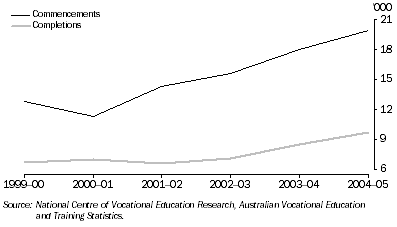
However, the gap between apprenticeship and traineeship commencements and completions has widened over the last three years, suggesting that more people are either failing to finish their training or postponing their training for a period of time. Either way, this has had a negative impact on the supply of these skills to the labour market. The discrepancy between the number of commencements and completions rose from 7,700 persons in 2001-02 to 10,200 persons in 2004-05.
The main occupation groups driving the growth in apprentice and trainee commencements over the last three years were Trades and related workers (up 3,100 persons or 73.8%) and Clerical, sales and service workers (up 2,600 persons or 56.5%). Driving the increase in completions of apprenticeships and traineeships were Intermediate production and transport workers (up 1,500 persons or 750.0%), Clerical, sales and service workers (up 900 persons or 40.9%) and Labourers and related workers (up 700 persons or 87.5%).
APPRENTICES AND TRAINEES |
|  |
 | 2001-02 | 2004-05 | Change |  |
 | '000 | '000 | '000 | % |  |
Commencements |  |
|  |
| Managers, administrators and professionals(a) | 0.6 | 1.0 | 0.4 | 66.7 |  |
| Trades and related workers | 4.2 | 7.3 | 3.1 | 73.8 |  |
| Clerical, sales and service workers(b) | 4.6 | 7.2 | 2.6 | 56.5 |  |
| Intermediate production and transport workers | 2.7 | 1.9 | -0.8 | -29.6 |  |
| Labourers and related workers | 2.2 | 2.5 | 0.3 | 13.6 |  |
| Total | 14.3 | 19.9 | 5.6 | 39.2 |  |
Completions |  |
|  |
| Managers, administrators and professionals(a) | 0.5 | 0.4 | -0.1 | -20.0 |  |
| Trades and related workers | 2.9 | 2.9 | - | - |  |
| Clerical, sales and service workers(b) | 2.2 | 3.1 | 0.9 | 40.9 |  |
| Intermediate production and transport workers | 0.2 | 1.7 | 1.5 | 750.0 |  |
| Labourers and related workers | 0.8 | 1.5 | 0.7 | 87.5 |  |
| Total | 6.6 | 9.7 | 3.1 | 47.0 |  |
|  |
| - nil or rounded to zero (including null cells) |
| (a) Includes Associate professionals. |
| (b) Includes Advanced clerical and service workers, Intermediate clerical, sales and service workers and Elementary clerical, sales and service workers. |
| Source: National Centre for Vocational Education Research, Australian Vocational Education and Training Statistics, June Quarter 2005, Summary. |
The gap between apprenticeship (and traineeship) commencements and completions for Trades and related workers rose substantially over the last three years, from 1,300 persons in 2001-02 to 4,400 persons in 2004-05. This result coincided with an increase of 7,545 Trade skilled vacancies over the same period, mainly driven by vacancies in Construction trades (up 2,745) and Metal trades (up 2,567).
ECONOMIC IMPACTS
Shortages of skilled labour have the ability to constrain the growth of an economy as labour is an important input to the process of production. During times of rapid economic growth, the available supply of skilled labour can be quickly exhausted, which can affect the ability of the economy to sustain its growth rate. Economic growth can be seriously impaired if the industries experiencing the labour shortages are the key drivers of the economy. Skills shortages can also affect the growth of an economy by raising wages and consumer prices, which may require a tightening response from the Reserve Bank of Australia in the form of interest rate increases.
It is important to note that the impact of skills shortages on economic performance is very hard to quantify or assign direct causation. What can be achieved through time series analysis is an understanding of the degree of correlation between movements in labour market indicators of skills shortages and data relating to the performance of the economy.
ECONOMIC GROWTH
In 2004-05, growth in the Western Australian economy fell below its long run average for the time since 2000-01. Growth in the volume of state production fell from 8.1% in 2003-04 to 2.7% in 2004-05, the most severe annual decline since the series began in 1990-91.
GROWTH IN GROSS STATE PRODUCT, Chain volume measures
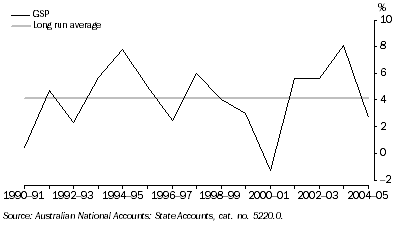
The relationship between economic growth and employment growth can be a potential cause of this fall in production. There has been a large difference between economic growth and employment growth in recent years - the largest since the series began in 1991-92. There was, however, a convergence in 2004-05, as economic growth fell and employment growth rose. Given that labour is an important input to the production process, especially in key Western Australian industries such as Construction, Manufacturing and Property and business services, employment growth appears to have failed to respond fast enough to sustain economic growth at rates experienced over the previous three years.
GROWTH IN GSP(a) AND EMPLOYMENT(b)
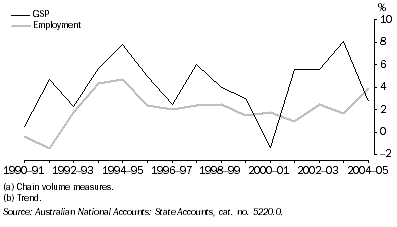
Indications are, however, that GSP growth will rise in 2005-06, supported by strong employment growth in 2004-05 and a significant recovery in business investment in the state.
BUSINESS INVESTMENT
Business investment has been one of the main reasons why the Western Australian economy has grown so rapidly in recent years. Investment has increased the production capacity of the state's major industries. In trend chain volume terms, investment in the state increased by 74.9% ($4,235 million) over the last three years, to reach a record high of $9,886 million in 2004-05. The main industries contributing to growth were Mining (61.7%), Other selected industries (comprising Retail, Construction and Property and business services) (21.9%) and Manufacturing (16.4%).
However, growth in business investment slowed considerably in 2004-05, declining to 11.5% ($1,017 million) from 28.2% ($1,952 million) in 2003-04. This was mainly the result of capital investment plans in the resources sector being brought forward in 2003-04 to help satisfy the surge in demand for raw materials from China, and the completion of the 4th LNG train on the North West Shelf in 2004-05. The deceleration in investment growth in 2004-05 coincided with the height of the skills shortage in Western Australia and it is likely that the limited supply of skilled workers in the state's construction industry had some impact on investment plans in that year.
BUSINESS INVESTMENT, Chain volume measures: Trend
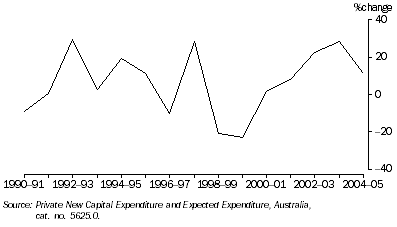
Data show that investment growth mainly fell on Equipment, plant and machinery, from 31.1% ($1,201 million) in 2003-04 to 1.0% ($52 million) in 2004-05, while investment growth on Buildings and structures rose slightly, from 24.2% ($742 million) in 2003-04 to 25.5% ($970 million) in 2004-05. The slowdown of investment growth on Equipment, plant and machinery is consistent with the end of the equipping phase of the previous cycle of investment on Buildings and structures, but also with reports that plant development (e.g. Burrup Ammonia plant) in the state's resources industry is becoming less feasible as a result of rising labour and material costs.
INFLATION
Economists define inflation as a persistent and appreciable rise in the general level of prices. Inflation occurs as either demand-pull inflation or cost-push inflation. Demand-pull inflation occurs when high levels of demand for goods and services cause prices to rise. This may involve an excess level of demand for labour in sectors of the economy where shortages of labour cause prices to rise. Cost-push inflation occurs when rising production costs are passed on to consumers as higher prices for goods and services. One source of cost pressures occur when wages growth exceeds productivity growth (i.e. output per worker). During periods of labour or skills shortage, wages growth has a tendency to outstrip productivity growth, as jobs are filled with less qualified or less experienced workers, who require further training and experience before they become fully effective in their jobs. Data suggest that wages have risen solidly in Western Australia over the period of skills shortage, particularly in 2004-05.
The Wage Price Index (WPI) measures changes in the price of labour unaffected by changes in the quality or quantity of work performed, ensuring that only the 'pure' price change is reflected. The WPI of total hourly rates of pay (excluding bonuses), which includes ordinary time and overtime rates of hourly pay, rose by 11.6% in Western Australia between 2001-02 and 2004-05, marginally higher than the 11.3% growth nationally. The largest discrepancy occurred in 2004-05, with wages growth of 4.3% in Western Australia, compared to 3.8% in Australia.
WAGES(a) GROWTH
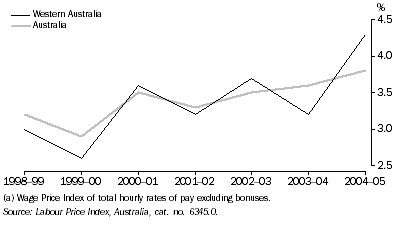
There is a relationship between movements in wages and consumer prices. As wages rise, firms may charge higher prices for the goods and services they produce to maintain revenue or profit margins. A wage-price spiral can occur if the economy is operating above full employment, as rising wages cause higher prices and higher prices feed higher wages. Although Western Australia has yet to reach full employment, there is strong evidence to suggest that it is operating closer to full employment than it has for some time. The evidence centres around the record high rates of labour force participation, record low unemployment and very high levels of capacity utilisation experienced in the state in recent years.
There has been a strong positive correlation between wages and consumer price growth in Western Australia since the beginning of the decade, although wages growth outpaced consumer price growth in each year from 2001-02 to 2004-05. Wages rose by 3.8% on average per year over the period, while consumer prices rose by 2.8% per year. In 2004-05, Western Australia's CPI growth of 3.2% was well above national growth of 2.4%, for the first time since 1998-99.
GROWTH IN WAGES VS CONSUMER PRICES
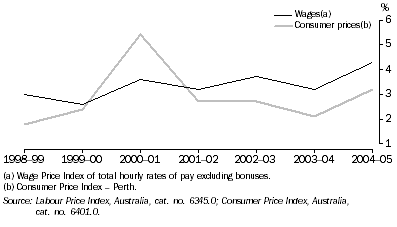
The degree to which skills shortages have caused wages growth in Western Australia, and in turn fed into consumer price inflation, can be examined by analysing the wages growth in some of the industries identified as most affected by skills shortage, as well as the prices of goods and services produced by those industries. Data show that recent wages growth in Western Australia was mostly driven by industries where skilled labour had been in short supply.
Wages in the Construction industry rose by 18.2% between 2001-02 and 2004-05, much higher than the 11.6% rise in general wages across the state. Much of the rise in Construction wages occurred in 2004-05, accelerating by 10.3% in that year, more than twice the state average of 4.3%. Coinciding with rising wages in the Construction industry, the price of purchasing a newly constructed house climbed sharply in Perth in recent years. Perth's price index of project homes rose by 26.3% between 2001-02 and 2004-05, while the price index of materials used in house building rose by 9.8% over the same period.
Wages in the Manufacturing industry increased by 13.0% between 2001-02 and 2004-05, above the 11.6% growth in general state wages. Wages growth in Manufacturing was also most pronounced in 2004-05, rising by 4.8%, compared to the state average in that year of 4.3%. The Mining industry also showed solid growth in wages, particularly in 2004-05, rising to 4.7% from 3.0% in 2003-04. In the Health and community services industry, annual wages growth was above the state average between 2001-02 and 2003-04; while the price of Health services (including hospital, medical, optical and dental) rose by 22.9% for Perth consumers between 2001-02 and 2004-05, well above the 8.2% rise across all goods and services in Perth.
LABOUR PRODUCTIVITY
One of the major drivers of economic growth is labour productivity or the amount of output produced per unit of labour. Growth in labour productivity occurs when the volume of output rises faster than the volume of input from labour in the process of production. During a period of skills shortage, labour productivity may be affected in two ways (or a combination of both). A shortage of skilled labour may lead to gains in labour productivity as employers increasingly utilise their existing workers. Conversely, labour productivity may fall because employers are forced to fill skilled positions with less qualified or less experienced workers - as well as there being more workers moving into new jobs. For this analysis labour productivity is measured by dividing an index of the volume of value added (GSP) by an index of labour input (hours worked) for the Western Australian economy.
In 2004-05, labour productivity recorded its first fall in Western Australia after three years of strong growth. Labour productivity declined by 2.4% in 2004-05, reflecting a 5.1% increase in the hours worked measure of labour input against a 2.7% increase in Western Australian output (GSP). Despite this decline, labour productivity rose by 5.1% between 2001-02 and 2004-05. This pattern in labour productivity appears to suggest that employers continued to increasingly utilise their existing workers during the initial stages of the skills shortage, but as employment rose rapidly against production in 2004-05, the productivity of labour was adversely affected.
LABOUR PRODUCTIVITY
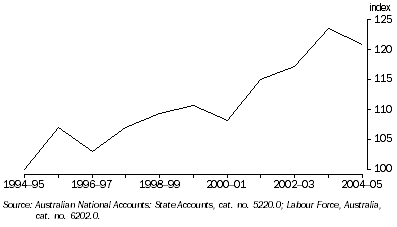
Since 2000-01, the volume of labour input has grown by 2.6% per year on an hours worked basis. This growth has seen average weekly hours worked by various occupations rise over the skills shortage period. Between 2001-02 and 2004-05, the largest increases were recorded for Intermediate production and transport workers (2.6 hours per week) and Labourers and related workers (2.0 hours per week), which were two of the occupation groups most affected by skills shortages.
INDUSTRY PERFORMANCE
Labour intensive industries are more likely to be affected by a skills shortage than capital intensive industries. Industries can also be affected to varying degrees by the relative strength of growth between industries. The performance of an industry affected by skills shortages tends to follow a pattern of accelerated growth for a lengthy period of time, followed by a marked deceleration, as the shortage of workers begins to constrain the growth of the industry. The performance of industries identified as most affected by skills shortages in Western Australia will be examined. These include Construction, Manufacturing, Property and business services, Mining and Health and community services.
Construction
Growth in the Construction industry rose substantially in 2001-02, with Total Factor Income (TFI) increasing by 18.2% or $710 million in that year, after a decline of 15.3% ($703 million) in the previous year. This appears to have been a catalyst for the skills shortage in Western Australia. Just prior to this period, there were reports of many construction workers and tradespersons leaving the state to work on the development of facilities and accommodation for the Sydney 2000 Olympics. Evidence of this appears in the employment data for the Construction industry, which fell by 5.5% between 1997-98 and 1998-99, as well as the state's net loss from interstate migration during this period.
CONSTRUCTION
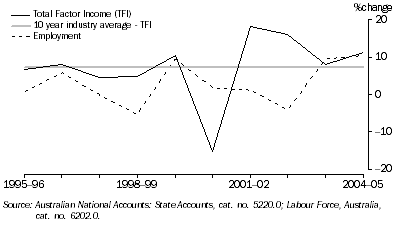
As shown on the graph above, growth in the Western Australian construction industry has remained above the long term industry average of 7.3% per year since 2001-02. TFI growth in Construction decelerated from 18.2% in 2001-02 to 7.9% in 2003-04 (with some recovery in 2004-05 at 11.4%). The general slowdown in construction activity may have been influenced by shortage of skilled labour in the industry, particularly Tradespersons and Building and engineering professionals. Employment growth in the Construction industry declined from 9.5% in 1999-2000 to -4.0% in 2002-03, with some recovery in the following two years.
Manufacturing
The Manufacturing industry began to recover in 2002-03 after two consecutive years of declining growth. Growth in the industry peaked in 2003-04, with TFI increasing by 15.1% or $1,068 million, but decelerated again in 2004-05 to 5.1%. Much of the expansion in the manufacturing industry was aided by the recent resources boom, boosting activities of minerals processing and metal products manufacturing. This pattern of strong growth followed by an acute deceleration is what can be expected from an industry experiencing shortages of skilled labour. The industry recorded a large fall in employment in 2003-04, declining by 7.5% - although employment did recover in 2004-05 (up 6.7%).
MANUFACTURING
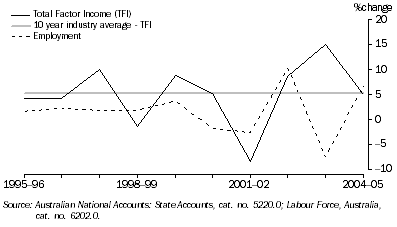
Property and business services
Activity in the Property and business services industry of Western Australia has been very strong in recent years, with TFI growth of 13.3% and 11.4% in the two years to 2003-04. The industry has been the beneficiary of the flow-on effects from increased activity in the state's construction and mining industries. Property services have benefited from the rising activity in the state's property market, while business services have benefited from the accelerated growth in the resources sector.
PROPERTY AND BUSINESS SERVICES
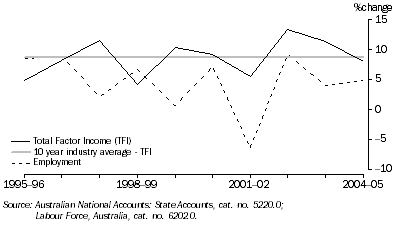
Again a familiar pattern has occurred in the activity of the Property and businesses industry, with growth accelerating above its long term trend of 8.7% in 2002-03 (13.3%), and then decelerating to 8.1% in 2004-05 - just below the industry long run average. This decline in growth coincided with a decline in employment growth in the industry from 9.2% in 2002-03 to 4.9% in 2004-05.
Mining
In conjunction with the Construction industry, the Mining industry also appears to have triggered the recent period of skills shortage in Western Australia. In 2000-01, TFI growth in Mining rose by 28.8% or $3,465 million. However, over the next three years growth in the Mining industry was quite subdued, as the industry began to invest in new production and transport capacity to meet the growing demand for minerals and energy from China. During this period, the industry recorded TFI growth of -0.5% (2001-02), 3.6% (2002-03) and -4.9% (2003-04). As new production and transport capacity came on-line, the industry experienced its largest period of growth in the last ten years, with TFI increasing by 29.4% ($4,462 million) in 2004-05. The fact that the industry was so subdued for such a lengthy period of time prior to 2004-05, could also have been caused by the curtailing of employment growth in the industry over that period. There was a distinct lack of building and engineering professionals and tradespersons to develop new mine capacity and infrastructure such as rail and ports during that time.
MINING
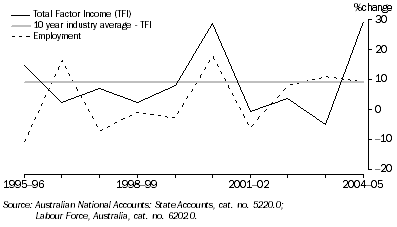
Health and community services
Growth in the state's Health and community services industry peaked in 2002-03 at 17.2% ($685 million), but has since declined to 3.6% ($180 million) in 2004-05, less than half the industry's long term average growth of 7.7% per year. This deceleration in growth corresponds with reports that the industry found it increasingly difficult to find doctors, nurses and child care workers to fill the large number of vacancies in these occupations. Employment growth in the industry over the last four years averaged only 2.7% per year, with the worst result being -3.2% in 2001-02 and the best 9.8% in 2003-04.
HEALTH AND COMMUNITY SERVICES
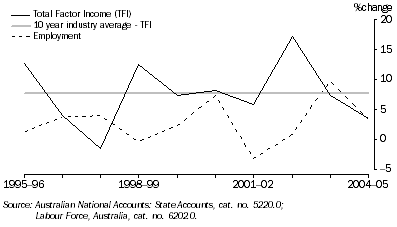
BUILDING AND ENGINEERING CONSTRUCTION BOTTLENECKS
In Western Australia, the construction industry has been a key driver of growth in the economy. Both building and engineering construction activity have risen strongly in recent years. The value of building activity rose by 52.6% over the last three years to $5,625 million in 2004-05, while engineering construction activity increased by 87.2% to $5,838 million over the same period.
CONSTRUCTION ACTIVITY, Value of work done: Original
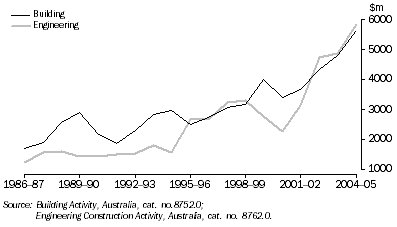
However, due to an insufficient supply of skilled workers (mainly Tradespersons and Building and engineering professionals), the capacity of the construction industry to meet the rising level of demand for new buildings and structures has diminished, prolonging the expansionary phase of the current building cycle and creating an increasing amount of work in the construction pipeline.
Western Australia is now experiencing its fourth cycle of residential building activity since the mid-1980s, with the latest cycle yet to fully reach its peak. Each cycle of building activity begins with a trough, then goes through a recovery or expansionary period, followed by a peak and then a downturn. The cycle of dwelling commencements also tends to lead the cycle of dwelling completions.
BUILDING ACTIVITY, Dwelling units: Trend
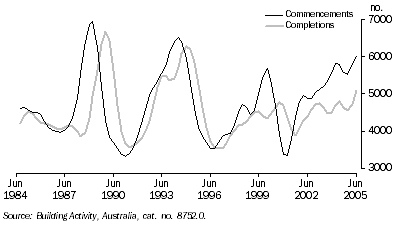
In the latest cycle the gap between dwelling commencements and completions has continued for a lengthy period of time, from around 2001-02 to the current day, which is unlike the previous cycles where completions managed to rise above commencements around one year after the peak in commencements. The inability of the industry to close the gap between the number of dwellings commenced and completed suggests that the demand for new dwelling construction has continued to rise strongly, and that the skills shortage in the building industry has caused delays in dwelling completions, extending the current expansionary phase of the building cycle.
Non-residential construction activity has shown a similar pattern whereby peaks in building completions have lagged behind commencements. It took a long time for non-residential building work to be completed after commencements peaked in September 2002 and commencements were relatively subdued until early 2005. Given that skills shortages were being experienced by the construction industry during this period, it appears to have had an impact on lengthening of the lag between commencements and completions.
NON-RESIDENTIAL BUILDING ACTIVITY: Original
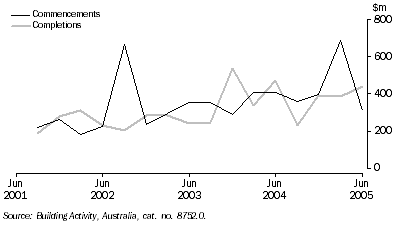
Another effect of the increasing gap between building commencements and completions has been an increase in the amount of building work in the pipeline. In Western Australia, the value of planned building work has more than doubled (up 123.9%) over the last three years to $2,693 million in 2004-05. Most of this rise can be attributed to the build-up of work in House construction (up 131.6%), while Non-residential building (up 116.4%) and Other residential building (up 115.1%) also contributed to the increase in building work in the pipeline.
BUILDING WORK IN THE PIPELINE |
|  |
 | 2001-02 | 2004-05 | Change |  |
 | $m | $m | $m | % |  |
|  |
| Houses | 607 | 1 406 | 799 | 131.6 |  |
| Other residential building | 225 | 484 | 259 | 115.1 |  |
| Non-residential building | 371 | 803 | 432 | 116.4 |  |
| Total building | 1 203 | 2 693 | 1 490 | 123.9 |  |
|  |
| Source: Building Activity, Australia, cat. no. 8752.0. |
The same situation has occurred in engineering construction activity in Western Australia. Between 2001-02 and 2004-05, the value of work in the engineering construction pipeline more than doubled (up 126.3%) from $2,547 million to $6,478 million. The gain was recorded across most types of engineering construction activity, including the largest rise of $2,759 million in Heavy industry construction, as well as a substantial increase in Bridges, railways and harbours, up from $46 million in 2001-02 to $1,080 million in 2004-05.
 Print Page
Print Page
 Print All
Print All